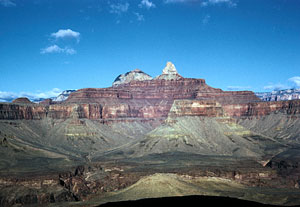 |
Geologic formations in Grand Canyon. An erosional remnant of Coconino Sandstone forms the white spire at the top of the ridge. |
Drilling into the earth is like a journey back in time. As the drill bit descends, it passes through rock formations that were deposited millions of years ago. For example, the formations at WESTCARB’s Arizona Pilot location on the Colorado Plateau are composed of sediments that were deposited between 374 to 240 million years ago. As these sediments were buried by relatively younger sediments, they became compacted and cemented to form sedimentary rocks.
These formations contain fossils of plants and animals that existed during the time of deposition of the sediments. The fossils are mainly extinct species, but their environmental significance can be interpreted because the broad biological categories to which they belong are still living on the Earth, and are adapted to specific environments.
For example, brachiopods, crinoids, echinoids, and corals, which presently live only in marine environments, are common fossils in the Martin Formation and the Naco Formation. It is therefore logical to interpret the environment of deposition of these formations as marine.
Similarly, fossil plants with tissues and structures that are similar to those living on land today can logically be interpreted as having been buried in sediments that were deposited in terrestrial environments such as rivers and lakes. Such fossil plants have been found in the Supai Formation and the Moenkopi Formation, both of which also have abundant sedimentary structures as mud cracks and stream-formed ripple marks.
The characteristic cross-bedding in the Coconino Sandstone can be compared with similar features now forming in wind-blown sand dunes in modern desert environments. The Coconino Sandstone also has fossilized footprints of animals, which are similar to those formed by lizards today. Thus, over millions of years, the Colorado Plateau has experienced many climactic and environmental transitions to which the formations bear witness.
|
|
How Are Geologic Formations Determined?
The fundamental unit used to classify and map layers of rock is the geologic formation, which consists of consecutive rock layers that share a particular set of characteristics. A formation must be distinctive enough in appearance that a geologic mapper can tell it apart from the surrounding rock layers; it must be thick enough and extensive enough to plot on a map.
If the formation consists of a single or dominant rock type, such as shale or sandstone, then the rock type is included in the name—Coconino Sandstone, for example. However, formations often contain a variety of related or interlayered rock types, in which case, the word "formation" is used.
Formations sometimes contain “members,” which are sub-units of rock with distinguishing characteristics within the formations.
|
|

